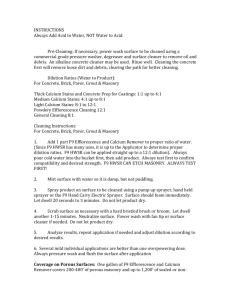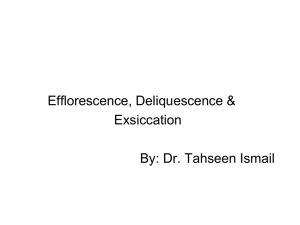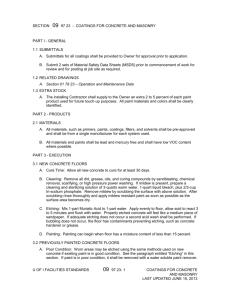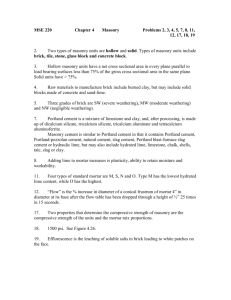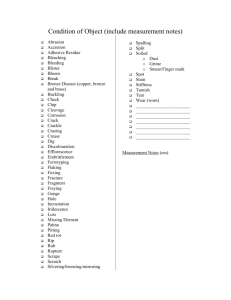CBD-2. Efflorescence
advertisement
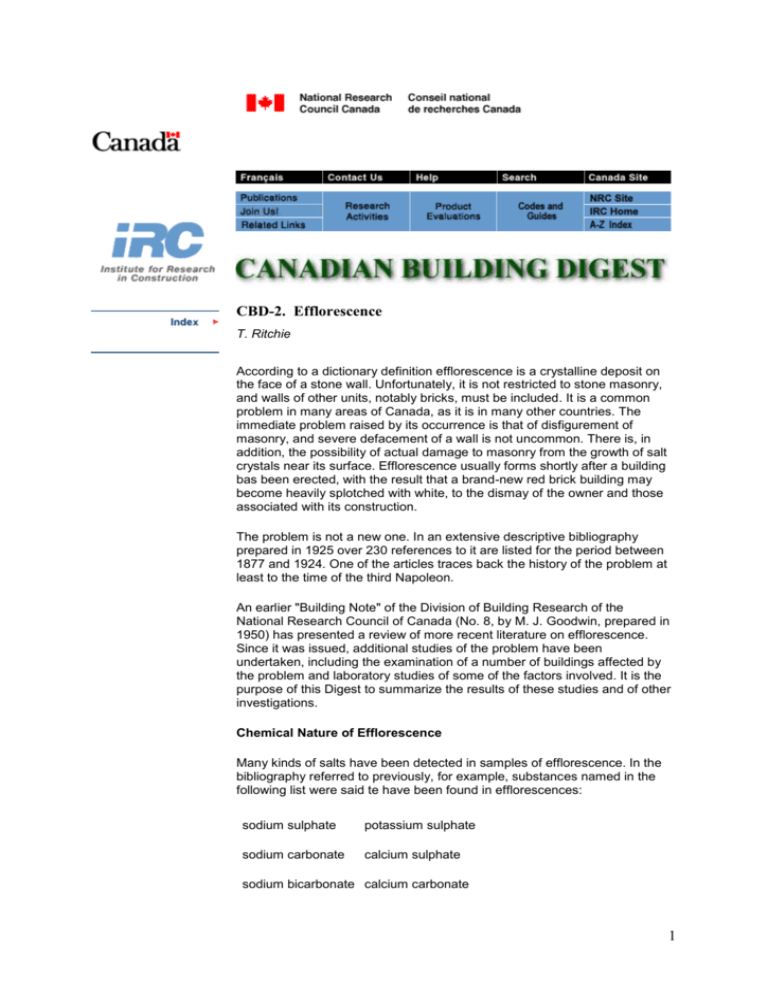
CBD-2. Efflorescence T. Ritchie According to a dictionary definition efflorescence is a crystalline deposit on the face of a stone wall. Unfortunately, it is not restricted to stone masonry, and walls of other units, notably bricks, must be included. It is a common problem in many areas of Canada, as it is in many other countries. The immediate problem raised by its occurrence is that of disfigurement of masonry, and severe defacement of a wall is not uncommon. There is, in addition, the possibility of actual damage to masonry from the growth of salt crystals near its surface. Efflorescence usually forms shortly after a building bas been erected, with the result that a brand-new red brick building may become heavily splotched with white, to the dismay of the owner and those associated with its construction. The problem is not a new one. In an extensive descriptive bibliography prepared in 1925 over 230 references to it are listed for the period between 1877 and 1924. One of the articles traces back the history of the problem at least to the time of the third Napoleon. An earlier "Building Note" of the Division of Building Research of the National Research Council of Canada (No. 8, by M. J. Goodwin, prepared in 1950) has presented a review of more recent literature on efflorescence. Since it was issued, additional studies of the problem have been undertaken, including the examination of a number of buildings affected by the problem and laboratory studies of some of the factors involved. It is the purpose of this Digest to summarize the results of these studies and of other investigations. Chemical Nature of Efflorescence Many kinds of salts have been detected in samples of efflorescence. In the bibliography referred to previously, for example, substances named in the following list were said te have been found in efflorescences: sodium sulphate potassium sulphate sodium carbonate calcium sulphate sodium bicarbonate calcium carbonate 1 sodium silicate magnesium sulphate In addition, other salts such as chlorides and nitrates, and salts of vanadium, chromium and molybdenum were mentioned without giving their specific composition. These last, particularly vanadium, were said to produce green efflorescence on white or buff burned clay units, while the other salts produced white or grey deposits. Efflorescence derived from complex vanadium compounds contained in the clay used in brick manufacture is not uncommon in the south-western part of the United States. For several years, as a part of studies of the Division of Building Research, samples of efflorescence have been taken from buildings and analyzed chemically. Many different types of bricks had been used. In all cases except one, the sample of efflorescence was obtained from the brick surface; in the exception, the bricks of the wall were unmarked by efflorescence, but the mortar joints had heavy salt deposits which projected ¼ to ½ inch from the surface. In all except the mortar joint efflorescence, chemical analysis of the sample indicated that a very large proportion of it was sodium sulphate and potassium sulphate. For the mortar joint efflorescence, however, sodium carbonate was indicated to be the main constituent. The samples contained small amounts or traces of other materials as well. In one sample from the wall of a building in which very high humidity is maintained throughout the winter and unusual efflorescence patterns form beneath windows, it was indicated that magnesium sulphate was present in considerable amounts, in addition to sodium and potassium sulphate. In other samples calcium was present in some quantity as carbonate or sulphate. Chloride was either not detected in the samples or was present only in very small quantity. The "common denominator" of all the samples analyzed was some salt of sodium and potassium. In all but one case, that of an unusual mortar joint efflorescence, the salt appeared to be sodium and potassium sulphate. The mortar joint efflorescence appeared to be sodium carbonate. The results of these analyses confirm a previous Canadian study of brick masonry efflorescence made by R. K. Robertson who noted that "... in all cases of serious efflorescence, sodium sulphate was invariably present, rarely being under 50% of the total content", an observation based on analysis of a great many samples taken over many years. It was reported also that other salts generally found in efflorescence are sodium carbonate, magnesium sulphate, calcium sulphate, calcium carbonate and sometimes slight traces of sodium chloride. Weather and Efflorescence It has been observed that efflorescence is usually a seasonal problem. The cool days and nights of the fall season seem to bring out salts which have not been seen on the surface in the summer. The intensity of efflorescence usually increases throughout the winter season and starts to decrease only in the spring. By summer the salt deposits have generally entirely disappeared. In many cases the amount of efflorescence on brick walls decreases from year to year, so that a building badly affected in the first winter after construction may be much less marked in the second, less still in the third, and entirely unaffected in the following winter. 2 To account for the "cold weather" development of efflorescence, there is a possibility that the rate of evaporation of moisture from brick masonry walls varies from season to season. Under summer conditions the rate may be very high, so that moisture is evaporated within the bricks and the soluble salts are deposited within the brickwork rather than on the surface. In colder weather, however, the evaporation rate may be quite slow; this allows moisture to move to the outer surface of the masonry before evaporating and leave the salt deposits on the surface. Mortar as a Source of Efflorescence It has been noted by many investigators that the occurrence and amount of efflorescence bears some relationship to the composition of the mortar used; with a particular type of brick and a certain mortar no efflorescence may develop on the masonry, whereas the same brick with another mortar may produce brickwork heavily marked by salt deposits. The preponderance of sodium and potassium salts (usually as sulphates) in most efflorescence suggests portland cement as their source. In one of the Division's studies small cylinders of mortar covering a wide range of compositions were moulded with a porous ceramic wick embedded in the upper part of the mortar. After hardening, the mortar was placed in water which permeated the sample and carried soluble salts, if any were present, to the wick. The water, on evaporating from the wick, deposited the salts, the amount and composition of which could be determined. It was found that mortars made of cementing materials which were low in content of sodium and potassium compounds produced very little efflorescence on the wicks. Such materials included three types of lime, and a low-alkali masonry cement. The use of portland cement to replace lime in mortar was found to increase the amount of efflorescence, depending on how much portland cement was used and on the amount of sodium and potassium salts it contained. In another study made in the Division, brick masonry piers were constructed outdoors of three types of bricks and of six mortars which contained various proportions of sand, lime and portland cement. This study also showed that, for the materials used, the amount of portland cement in the mortar influenced the amount of efflorescence. The study also indicated that the type of brick determines whether efflorescence will occur or not. When a brick with a high rate of water absorption was used with a high-cement mortar, the pier was heavily marked by efflorescence, although a corresponding pier of the same mortar and brick of a moderate rate of water absorption was only slightly marked. The third pier, of brick with a low rate of water absorption, was unmarked by efflorescence even though the same mortar was used. The mortar of the three piers was identical in composition; the nature of the brick, however, seemed to govern the movement of the salts through the brickwork. In one case the salt solution apparently moved freely; in the other cases the movement was more restricted owing to the nature of the bricks. Additional Sources of Efflorescence Although mortar is an important source of the salts of efflorescence, it is by no means the only one. Masonry units may contain appreciable amounts of salts which are dissolved by moisture and brought to the surface when the units weather. In the case of bricks a standard test may be made to show their capacity to contribute to efflorescence through soluble salt content. A brick is placed on end in a pan of distilled water for seven days, in which time water is drawn upwards through the brick and evaporated from the 3 surface. Soluble salts in the brick are taken into solution by the water and on its evaporation are deposited on the surface. The movement of ground water into building foundations and its passage upwards into masonry by "wicking" action is sometimes the cause of efflorescence when soil moisture carries with it soluble salts which later are deposited on the masonry surface. Efflorescence frequently forms on brickwork adjoining concrete units. A good example of this is its occurrence beneath concrete window sills. In such a situation concrete frequently is wetted from rain and snow melting on it, and soluble salts of the concrete are dissolved and may be carried into the brickwork beneath. Salts which cause efflorescence may also originate in the back-up masonry behind the facing of a wall. Initially, the face may be free of salts, but later become contaminated from salts of the backing materials. Prolonged dampness in walls also promotes efflorescence. Thus masonry near defective drains is often marked by efflorescence while other parts of the walls are unaffected; and walls which are splashed with water from nearby horizontal surfaces may be similarly marked. Treatment of Efflorescence The usual method of removing efflorescence from brick walls is either to dissolve the salts by rinsing with water, at the same time scrubbing with a brush, or similarly to dissolve them in a dilute hydrochloric acid solution and follow by rinsing the solution from the wall. In both cases it is probable that some of the salts will be carried back into the masonry when the wall is wetted and subsequently again from efflorescence. The acid treatment, however, appears to be successful in a high proportion of the occasions it is used. When efflorescence is associated with abnormal wetting of the wall, as from faulty drains or adjacent water tables, it is of course necessary to correct these faults before attempting to remove the efflorescence. When the problem is due to the rise of ground water it is very difficult to correct, since some form of horizontal damp-proof course must be inserted in the base of the wall to prevent continued rise of moisture. Similarly, when brickwork beneath window sills or copings is affected by efflorescence, proper treatment involves the installation of a damp-proof course to interrupt movement of moisture into the brickwork. Precautions Against Efflorescence Since so many factors may contribute to the development of efflorescence on masonry, no one precautionary measure can be expected to take care of all eventualities. In order for efflorescence to form, however, soluble salts must be present in masonry. Some control may therefore be afforded by the selection of materials which are low in content of such salts. Clay and shale bricks, for example, may be tested according to standard methods to determine whether they contain salts which will contribute to efflorescence. Although there is no standard test available for assessing the capacity of mortar to contribute to efflorescence, cementing materials for mortar are available which are low in content of salts producing efflorescence, of which sodium and potassium compounds appear to be important. The use of lime, and of low-alkali portland cement and low-alkali masonry cement will greatly reduce the capacity of mortar to contribute to efflorescence. Careful storage 4 of the masonry materials on the job site is also necessary to avoid contamination from salt-carrying ground water. Certain features of building design may make the difference between the occurrence or avoidance of efflorescence. A suitable damp-proof course, such as metal foil, installed above grade between foundation and masonry wall, will prevent upward movement of ground water which otherwise might carry salts into the wall. Similarly, properly designed and carefully installed flashings between concrete window sills and copings will guard against a common source of efflorescence. The over-all design of a building to ensure that the walls are kept as dry as possible in service, such as by the use of a roof of considerable overhang and the avoidance of horizontal surfaces adjacent to masonry, unless adequately shielded from splashing and water flow into it, are features that offer protection against efflorescence. If water drains are placed against masonry they should be of ample capacity, and they should be maintained in serviceable condition. In short, the design of a building with respect to obtaining the maximum degree of durability of masonry by protecting it from excessive dampness will also be favourable to the avoidance of efflorescence. Use of Water-Repellents to Suppress Efflorescence In recent years there has been developed a new class of materials called silicones, which have come into use in the building field mainly in connection with attempts to correct problems of penetration of rain into unit masonry. Some manufacturers also advocate their use for the prevention of efflorescence on masonry walls. When a brick or some other type of unit is treated with silicone, its surface usually becomes highly water-repellent. Formation of efflorescence on that surface is then usually suppressed because solutions of salts in the brickwork are prevented from moving to the surface to evaporate as would normally be the case. The moisture evaporates beneath the treated surface, however, and salt deposits accumulate there rather than on the surface. Localized accumulation of salts and their crystallization may cause the surface of the brick to be spalled or flaked off, so that the use of a silicone treatment to suppress efflorescence may be dangerous in some cases. This is particularly true when there are large amounts of salts in the masonry and the units are soft and porous. Unfortunately, no specific rule to ensure elimination of the danger is yet known. A different application of silicones to the efflorescence problem has been reported in the United States, where in some brick plants the bricks are treated with silicone solution before use in construction. The effect of such a treatment on the occurrence of efflorescence and on other properties of brickwork is currently under study in the Division of Building Research and other organizations. Summary The problem of efflorescence on unit masonry walls is an old one which has been studied for a great many years. Several factors may influence the occurrence of efflorescence in a particular case, but there must be salts in the masonry to be taken into solution by water and then deposited on the surface as the moisture dries. The movement of the solutions within masonry is controlled to some considerable extent by seasonal weather, 5 and efflorescence is usually a "cold weather" problem. Possible sources of the salts of efflorescence have been described; these include the masonry materials used, the mortar, units and backing, as well as "outside" contaminants such as ground water. Design features of a building which prevent excessive wetting of the masonry and prevent contamination of "clean" parts from those containing salts of efflorescence are desirable. Precautionary measures against efflorescence should therefore include the selection of materials with a low content of the salts of efflorescence and, equally important, the overall designing of a building to protect masonry from excessive wetting. Originally published February 1960. Important Notices 6
